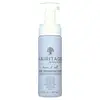What's inside
What's inside
 Key Ingredients
Key Ingredients

 Benefits
Benefits

 Concerns
Concerns

 Ingredients Side-by-side
Ingredients Side-by-side

Water
Skin ConditioningPropane
Isobutane
Pvp
Emulsion StabilisingParfum
MaskingEthylhexylglycerin
Skin ConditioningBenzyl Alcohol
PerfumingPolyquaternium-11
Propylene Glycol
HumectantLaureth-4
EmulsifyingPolyquaternium-4
Cocamidopropyl Betaine
CleansingCetrimonium Chloride
AntimicrobialCaryocar Brasiliense Fruit Oil
Skin ConditioningRosa Canina Seed Oil
EmollientGlycerin
HumectantSalvia Officinalis Leaf Extract
CleansingTocopherol
AntioxidantPhenoxyethanol
PreservativeWater, Propane, Isobutane, Pvp, Parfum, Ethylhexylglycerin, Benzyl Alcohol, Polyquaternium-11, Propylene Glycol, Laureth-4, Polyquaternium-4, Cocamidopropyl Betaine, Cetrimonium Chloride, Caryocar Brasiliense Fruit Oil, Rosa Canina Seed Oil, Glycerin, Salvia Officinalis Leaf Extract, Tocopherol, Phenoxyethanol
Water
Skin ConditioningPolysorbate 20
EmulsifyingPolyquaternium-11
Glycerin
HumectantPolyquaternium-55
Hydrolyzed Quinoa
Skin ConditioningHydrolyzed Rice Protein
Skin ConditioningCaprylic/Capric Glycerides Polyglyceryl-10 Esters
EmollientCoconut Alkanes
EmollientCamellia Sinensis Leaf Extract
AntimicrobialCoco-Glucoside
CleansingCoco-Caprylate/Caprate
EmollientPanthenol
Skin ConditioningGuar Hydroxypropyltrimonium Chloride
Skin ConditioningParfum
MaskingPhenoxyethanol
PreservativeBenzyl Alcohol
PerfumingPotassium Sorbate
PreservativeSodium Benzoate
MaskingWater, Polysorbate 20, Polyquaternium-11, Glycerin, Polyquaternium-55, Hydrolyzed Quinoa, Hydrolyzed Rice Protein, Caprylic/Capric Glycerides Polyglyceryl-10 Esters, Coconut Alkanes, Camellia Sinensis Leaf Extract, Coco-Glucoside, Coco-Caprylate/Caprate, Panthenol, Guar Hydroxypropyltrimonium Chloride, Parfum, Phenoxyethanol, Benzyl Alcohol, Potassium Sorbate, Sodium Benzoate
Ingredients Explained
These ingredients are found in both products.
Ingredients higher up in an ingredient list are typically present in a larger amount.
Benzyl Alcohol is most commonly used as a preservative. It also has a subtle, sweet smell. Small amounts of Benzyl Alcohol is not irritating and safe to use in skincare products. Most Benzyl Alcohol is derived from fruits such as apricots.
Benzyl Alcohol has both antibacterial and antioxidant properties. These properties help lengthen the shelf life of products. Benzyl Alcohol is a solvent and helps dissolve other ingredients. It can also improve the texture and spreadability.
Alcohol comes in many different forms. Different types of alcohol will have different effects on skin. This ingredient is an astringent alcohol.
Using high concentrations of these alcohols are drying on the skin. They may strip away your skin's natural oils and even damage your skin barrier. Astringent alcohols may also irritate skin.
Other types of astringent alcohols include:
According to the National Rosacea Society based in the US, you should be mindful of products with these alcohols in the top half of ingredients.
Any type of sanitizing product will have high amounts of alcohol to help kill bacteria and viruses.
Learn more about Benzyl AlcoholGlycerin is already naturally found in your skin. It helps moisturize and protect your skin.
A study from 2016 found glycerin to be more effective as a humectant than AHAs and hyaluronic acid.
As a humectant, it helps the skin stay hydrated by pulling moisture to your skin. The low molecular weight of glycerin allows it to pull moisture into the deeper layers of your skin.
Hydrated skin improves your skin barrier; Your skin barrier helps protect against irritants and bacteria.
Glycerin has also been found to have antimicrobial and antiviral properties. Due to these properties, glycerin is often used in wound and burn treatments.
In cosmetics, glycerin is usually derived from plants such as soybean or palm. However, it can also be sourced from animals, such as tallow or animal fat.
This ingredient is organic, colorless, odorless, and non-toxic.
Glycerin is the name for this ingredient in American English. British English uses Glycerol/Glycerine.
Learn more about GlycerinParfum is a catch-all term for an ingredient or more that is used to give a scent to products.
Also called "fragrance", this ingredient can be a blend of hundreds of chemicals or plant oils. This means every product with "fragrance" or "parfum" in the ingredients list is a different mixture.
For instance, Habanolide is a proprietary trade name for a specific aroma chemical. When used as a fragrance ingredient in cosmetics, most aroma chemicals fall under the broad labeling category of “FRAGRANCE” or “PARFUM” according to EU and US regulations.
The term 'parfum' or 'fragrance' is not regulated in many countries. In many cases, it is up to the brand to define this term.
For instance, many brands choose to label themselves as "fragrance-free" because they are not using synthetic fragrances. However, their products may still contain ingredients such as essential oils that are considered a fragrance by INCI standards.
One example is Calendula flower extract. Calendula is an essential oil that still imparts a scent or 'fragrance'.
Depending on the blend, the ingredients in the mixture can cause allergies and sensitivities on the skin. Some ingredients that are known EU allergens include linalool and citronellol.
Parfum can also be used to mask or cover an unpleasant scent.
The bottom line is: not all fragrances/parfum/ingredients are created equally. If you are worried about fragrances, we recommend taking a closer look at an ingredient. And of course, we always recommend speaking with a professional.
Learn more about ParfumPhenoxyethanol is a preservative that has germicide, antimicrobial, and aromatic properties. Studies show that phenoxyethanol can prevent microbial growth. By itself, it has a scent that is similar to that of a rose.
It's often used in formulations along with Caprylyl Glycol to preserve the shelf life of products.
We don't have a description for Polyquaternium-11 yet.
Water. It's the most common cosmetic ingredient of all. You'll usually see it at the top of ingredient lists, meaning that it makes up the largest part of the product.
So why is it so popular? Water most often acts as a solvent - this means that it helps dissolve other ingredients into the formulation.
You'll also recognize water as that liquid we all need to stay alive. If you see this, drink a glass of water. Stay hydrated!
Learn more about Water